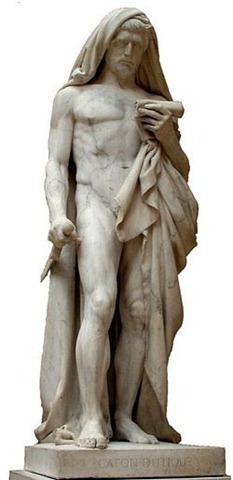Donald J. Robertson's Blog, page 79
March 16, 2013
Roundup of Recent Posts (March 2013)
March 14, 2013
The Philosophers of the Stoic School
Copyright © Donald Robertson, 2013. All rights reserved.
[Work in progress, links are still being added and minor corrections made.]
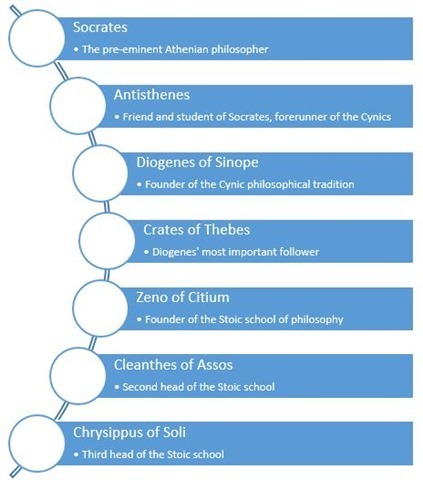 Diogenes Laertius describes a philosophical “succession” that begins with Socrates and leads through the major figures in the Cynic tradition down through the Stoic school, ending with Chrysippus. The diagram on this page illustrates his account of this philosophical lineage. Below are a list of some of the most important figures in the Stoic tradition, including the major Cynic precursors. I’ve indented less well-known or minor figures. Links are to pages on Wikipedia but you can also find a Wikipedia navigation menu for Stoicism. The precise chronological order is difficult to determine in some cases and so I’ve followed a rough chronology, placing the names of historically-related figures together.
Diogenes Laertius describes a philosophical “succession” that begins with Socrates and leads through the major figures in the Cynic tradition down through the Stoic school, ending with Chrysippus. The diagram on this page illustrates his account of this philosophical lineage. Below are a list of some of the most important figures in the Stoic tradition, including the major Cynic precursors. I’ve indented less well-known or minor figures. Links are to pages on Wikipedia but you can also find a Wikipedia navigation menu for Stoicism. The precise chronological order is difficult to determine in some cases and so I’ve followed a rough chronology, placing the names of historically-related figures together.
The Cynic Succession
Socrates, c. 469 BC – 399 BC, the pre-eminent Greek philosopher, who introduced the application of dialectic to ethical questions, especially the definition of the cardinal virtues, and the philosophical way of life
Antisthenes, 445 – 365 BC, the friend and student of Socrates, who founded a small sect after his death, and (perhaps doubtfully) was claimed to have been the major precursor of the Cynic school
Diogenes of Sinope, 412/404 – 323 BC, founder of the Cynic philosophical tradition; he probably never met Antisthenes, although he may have been inspired by his writings
Crates of Thebes, 365 – 285 BC, his most famous follower, and the teacher of Zeno of Citium
Zeno of Citium, c. 334 BC – c. 262 BC, began his philosophical career as a follower of Crates, and clearly adopted the Cynic lifestyle, perhaps for twenty years before founding his own school, the Stoa
Diogenes Laertius claims that the Stoics were part of a wider Ionian philosophical tradition, stretching back to the pre-Socratic philosophers Thales and Anaximander. They were clearly influenced by Heraclitus, who stands in this tradition, although Diogenes Laertius does not mention him as a major precursor of Stoicism for some reason. Zeno reputedly wrote a book entitled On Pythagoreanism and the influence of Neopythagorean ideas can be seen in the works of Epictetus and Seneca, in the Roman Imperial period. However, the most important influence precursor of Stoicism was probably Socrates. We’re told it was the desire to emulate his example, which he read about in Xenophon’s Memorabilia, that inspired Zeno to begin studying philosophy. Zeno then spent twenty years studying philosophy at Athens, attaching himself to three major Socratic sects
The Cynics, whose philosophy was his first and most important influence, after he became a follower of Crates of Thebes
The Megarian school, who specialised in logic and dialectic, but held a moral philosophy similar in some ways to the Cynics; Zeno studied under Stilpo the head of the school, probably the most popular philosophical teacher of his day, but also under members of the “Dialectician” sect associated with this school, particularly Diodorus Cronus
The Academy of Plato, where Zeno studied under the scholarchs Xenocrates and later his successor Polemo; Xenocrates had been a student of Plato, the founder of the school
Athens at this time was full of thinkers influenced by Socrates and Zeno was steeped in this Socratic atmosphere. He was exposed to the teachings of Socrates through these three major schools, which Diogenes Laertius places in a lineage going back to the immediate circle of students surrounding Socrates, claiming that the Cynic succession was founded by Antisthenes, whereas the Megarian school was founded by Euclid and the Academy by Plato – three associates of Socrates himself. A fourth Socratic influence was Xenophon, another friend of Socrates. Although his small school had ceased to exist by this time, Zeno was inspired by his writings portraying Socrates as a pre-eminent sage. It should also be noted that the Stoics appear to show more interest in poetry and drama than the other philosophical schools. They frequently quote Homer and Euripides in particular, and such writings clearly had some influence on them, perhaps mainly in providing examples of tragic figures who they would see as pathologically attached to wealth or reputation, although also sometimes they were a source of positive sayings and examples.
The Early Stoa (Athens)
Zeno of Citium, c. 334 BC – c. 262 BC, was the founder of the Stoa
Aristo of Chios, c. 320 – 250 BC, the most important “heterodox” Stoic mentioned by Diogenes Laertius, associate of Zeno who insisted on an ethical philosophy more resembling Cynicism, and rejected the importance of studying logic and physics
Herillus of Carthage, fl. 260 BC, an important “heterodox” Stoic mentioned by Diogenes Laertius, apparently a student of Zeno, who became critical of him, he defined the goal of life as knowledge and everything between virtue and vice as “indifferent”
Dionysius of Heraclea, dubbed “the Renegade”, 330 – 250 BC, an important “heterodox” Stoic mentioned by Diogenes Laertius, who abandoned Stoicism in favour of the Cyrenaic school, who viewed pleasure as the chief good in life
Aratus, 315/310 – 340 BC, an ancient poet-philosopher who apparently studied with Zeno, his Stoic-influenced didactic poem on natural philosophy Phaenomena survives and was quoted by St. Paul in Acts of the Apostles, speaking to an audience of Epicurean and Stoic philosophers in Greece
Persaeus of Citium, 307/306 – 243 BC, a favoured student of Zeno, who was sent in his place to become court advisor to King Antigonus II Gonatas of Macedonia
King Antigonus II Gonatas, ruler of Macedonia, who was interested in philosophy and reputedly attended the lectures of Zeno and was later had his student Persaeus as a court advisor
Cleanthes of Assos, c. 330 BC – c. 230 BC, was the second scholarch
Sphaerus of Borysthenes, c. 285 BC – c. 210 BC, important student of both Zeno and Cleanthes
Chrysippus of Soli, c. 279 BC – c. 206 BC, was the third scholarch
Zeno of Tarsus, fl. 200 BC, was the fourth scholarch
Diogenes of Babylon, c. 230-150/140 BC, was the fourth scholarch, visited Rome as part of an important ambassadorial delegation, along with the Academic Carneades and the Aristotelian Critolaus
Apollodorus of Seleucia, fl. 150 BC, an important student of Diogenes of Babylon, who may have been influential in promoting the Cynic-Stoic succession reported by Diogenes Laertius (see above)
Crates of Mallus, fl. 2nd century BC, Stoic natural philosopher who created the first known globe of the Earth
Antipater of Tarsus, d. 130/129 BC, was the fifth scholarch
The Middle Stoa (Roman Republic)
During this transitional and politically chaotic period, the scholarch Panaetius travelled to Rome to lecture and Stoicism started to become increasingly popular outside of Greece, particularly among important statesman and cultural figures in the Roman Republic. At the same time, key Stoics began to assimilate more elements of Platonic and Aristotelian philosophy, which may have contributed to the eventual disappearance of the formal institution of the Stoa and the dispersal of its remaining students and teachers.
Panaetius of Rhodes, c. 185 – c. 110/09 BC, was the sixth and perhaps the last scholarch of the Athenian Stoa, after his death the formal institution of the Stoa apparently fragmented, and eventually disappeared
Mnesarchus of Athens, c. 160 – c. 85 BC, was a student of Antipater of Tarsus, who was apparently one of the leaders of the residual Stoic school at Athens after the death of Panaetius
Hecato of Rhodes, fl. 100 BC, an important Stoic philosopher and student of Panaetius
Gaius Laelius Sapiens, b. c. 188 BC, called “the Wise”, Roman statesman who studied Stoic philosophy, close friend of Scipio the Younger; Cicero wrote a dialogue in his name about Stoic view on friendship
Scipio the Younger, Scipio Aemilianus Africanus, 185 – 129 BC, influential Roman statesman and general, who led the final destruction of Carthage; he formed a circle of friends interested in philosophy, including Stoicism, who were called the “Scipionic Circle”, and included the Stoic philosopher Panaetius
Posidionius of Rhodes, c. 135 BCE – 51 BC, was Panaetius’ most famous student, and may have led a Stoic school relocated to Rhodes, although he eventually seems to have abandoned Stoicism altogether
In 87 BC, during the period when Posidonius apparently led the Stoa, the Roman dictator Sulla sacked Athens and most of the formal philosophical schools closed down, perhaps fleeing to preserve their precious founding texts, transporting them to the safety of other locations. Moreover, Posidonius appears to have eventually broken away from the Stoic school and embraced Platonism and Aristotelianism instead.
A couple of years after the death of Posidonius, from 49-45 BC the Great Roman Civil War took place, in which the tyrant Julius Caesar overthrew the Roman Republic and established himself as dictator, marking the fall of the Roman Republic. Cato (a Stoic) and Cicero (an Academic) were major political opponents of Caesar. Cato ended up leading the remnants of the Republican army in their last stand against Caesar at Utica in North Africa. Seneca’s nephew, the Stoic poet Lucan would later describe the events of Civil War in his epic poem Pharsalia, which (paradoxically) portrays Cato the Younger as the moral victor, though defeated by Caesar, and as the supreme Stoic hero of the Roman world.
Marcus Tullius Cicero, 106 BC – 43 BC, Roman statesman and philosopher, not a Stoic but an Academic who was greatly influenced by Stoicism and one of our main sources for discussion of Stoic ideas, friend and rival of Cato; he was particularly influenced by the more eclectic Stoicism of Panaetius
Cato the Younger, 95 – 46 BC, Roman statesman, philosopher, and military leader, who gave his life at the end of the Civil War in defiance of Julius Caesar, did not write or teach but Cicero calls him the “complete Stoic”, and he was revered by subsequent generations as a Stoic hero
Antipater of Tyre, d. c. 45 BC, Stoic philosopher and friend of Cato the Younger, who introduced him to Stoic philosophy
Athenodorus Cordylion, of Tarsus, fl. 1st century BC, Stoic philosopher and keeper of the library at Pergamon, where he allegedly expunged passages from Zeno’s texts, seemingly those alluding to the more controversial aspects of Cynicism; he was persuaded by Cato to become his resident philosopher and relocated to Rome
A series of civil wars followed during the post-Republic period and the Roman Empire was eventually founded when Octavian was made the first Roman emperor, and named Augustus, in 27 BC. The Roman Imperial period therefore follows.
The Late Stoa (Roman Empire)
By the Roman Imperial period, the formal institution of the Stoa appears to have come to an end, but Stoic lecturers still exist for at least another two centuries, and Marcus Aurelius is the last famous Stoic we know about. Three of the most important Stoics of this period can be seen as aligned to the same branch of Stoicism: Musonius Rufus, Epictetus, and Marcus Aurelius. During this period, Stoicism lacked an orthodox centre of teaching and became somewhat fragmented, although there also seems to have been some desire to return to the orthodox teachings of the schools founders, through close study of the texts of Chrysippus in particular.
Arius Didymus of Alexandria , fl. 1st century BC, Stoic teacher of the Emperor Augustus, the first Emperor and founder of the Roman Empire
Horace, 65 – 8 BC, the leading Roman lyric poet during the reign of Augustus, was influenced by Epicureanism but increasingly by Stoicism in his later writings
Quintus Sextius, fl. 50 BC, Roman philosopher who combined Stoicism and Neopythagoreanism, much admired by Seneca, who studied with his follower Sotion
Athenodorus Cananites, c. 74 BC – 7 AD, Stoic philosopher, student of Posidonius
Attalus, fl. 25 AD, Stoic philosopher and teacher of Seneca, whom he much admired and frequently quotes
Sotion, fl. 1st century AD, philosopher who combined Neopythagoreanism and Stoicism, a teacher in the school of Quintus Sextius, who taught Seneca
Seneca the Younger, c. 4 BC – AD 65, was not a Stoic teacher but probably the focus of a small informal circle of Stoic friends, and tutor to the Emperor Nero
Lucan, 39 – 65 AD, the nephew of Seneca, a Stoic-influenced poet, and author of the Pharsalia, which portrays Cato as a Stoic sage
Persius, 34 – 62 AD, a Stoic poet, and friend of Lucan, several of whose Stoic-influenced Satires survive
Cornutus, fl. 60 AD, a Stoic philosopher and teacher, his Compendium of Greek Theology survives
Musonius Rufus, c. 20/30 AD – 79/101 AD, was the pre-eminent Stoic teacher of the Roman Imperial period, the head of an important school, but not an official scholarch of the Stoa
Epictetus, AD 55 – 135, was Musonius’ most influential student, and began lecturing at his own Stoic school during the same period as his teacher
Hierocles, fl. 2nd century AD, Stoic philosopher, author of Elements of Ethics
Sextus of Chaerona, fl. 160 AD, Stoic lecturer who taught Marcus Aurelius
Junius Rusticus, c. 100 – 170 AD, distinguished Stoic philosopher and personal tutor of Marcus Aurelius
Marcus Aurelius, 121 – 180 AD, was Roman Emperor and a student of Stoicism, who attended lectures by Stoic teachers, but seems most influenced by his reading of Epictetus’ Discourses, although they did not meet
After the death of Marcus Aurelius, Stoicism was gradually superseded by Neoplatonism, whose main pioneer was Plotinus, 205 – 270 AD, which was, in turn, ultimately eclipsed by Christianity.
Filed under: Stoicism Tagged: stoic, Stoic philosophy, stoicism








March 11, 2013
Verses from the Cynic Philosopher Crates of Thebes
We have several fragments of poetry attributed to Crates of Thebes, the Cynic philosopher who followed Diogenes of Sinope and was the first teacher of Zeno of Citium, the founder of Stoicism.
The first fragment, cited by Diogenes Laertius, treats their characteristic knapsack (pera) as a metonym for the Cynic life, portraying it as an ideal city, perhaps comparable to the ideal Republic postulated by philosophers of different schools. It is surrounded by an ocean of folly, or vapour (tuphos), the Cynic’s favourite word for the illusion of conventional values, the view of the majority that prizes “external goods” such as material wealth and public acclaim, etc. However, because this city is populated by people who live simple and wise life, with only the most basic possessions, ironically, they do not attract foolish or lewd citizens and their poverty means there is no reason for anyone to invade them. By “fair and fat”, he means beautiful and wealthy, in its own paradoxical way. The word for thyme is virtually identical to the word for courage or being highly “spirited” (thumos), which is apparently a play on words: the reader is to take it that the realm of the Cynic knapsack, by consisting of simple living, is characterised by the virtue of bravery.
There is a city, Pera in the wine-dark sea of folly,
Fair and fat, though filthy, with nothing much inside.
Never does there sail to it any foolish stranger,
Or lewd fellow who takes delight in the rumps of whores,
But it merely carries thyme and garlic, figs and loaves,
Things over which people do not fight or go to war,
Nor stand they to arms for small change or glory.
Again, from Diogenes Laertius, these lines express the Cynic notion of being a citizen of the world:
Not one tower does my country have, not one roof,
But for home and city, the entire earth lies
At my disposition for a dwelling.
Crates reputedly came from a wealthy family but disposed of all his money on becoming a Cynic. Here he refers to his former wealth as vapour (tuphos) again, implying its insubstantial and ephemeral nature. According to Diogenes Laertius, elsewhere he wrote:
This I own, what I have learned and thought, and the Muses’
Solemn precepts; but all my riches are gone like empty smoke.
The Greek Anthology includes the following lines of his Hymn to Frugality, which describes it as a species of temperance:
Hail, Goddess and Queen, beloved of the wise,
Frugality, worthy offspring of glorious Temperance,
Your virtues are honoured by all who practise righteousness.
Plutarch, in Rules for the Preservation of Health, cites these lines, commenting that Crates “believed that civil strife and despotism were brought about in the main by luxury and extravagance”. Lentil soup was a cheap and simple meal traditionally associated with the Cynic way of life:
Do not throw us into strife
By preferring fine dishes to lentil soup.
Teles of Megara quotes these lines, referring again to the characteristic knapsack of the Cynic, and another typically cheap meal associate with them, lupin seeds:
You have no idea what power a knapsack holds,
And a quart of lupins, and freedom from care.
Apparently, the meals emblematic of the Cynic way of life, lupins and lentil soup, are particularly associated with flatulence, and this happens to be a topic the Cynics also liked to mention.
Filed under: Cynicism Tagged: Cynic philosophy, Cynicism, poem, poems, poetry








March 10, 2013
The Cynic Prayer of Crates
 Crates of Thebes was Diogenes the Cynic’s most famous pupil and the main teacher of Zeno of Citium, the founder of Stoicism.
Crates of Thebes was Diogenes the Cynic’s most famous pupil and the main teacher of Zeno of Citium, the founder of Stoicism.
Glorious children of Mnemosyne and Olympian Zeus,
Pierian Muses, hearken to my prayer!
Grant me food without fail for my belly,
Which has ever made my life simple and unenslaved…
Make me useful rather than sweet to my friends.
Glorious goods I do not wish to gather, as one
Who yearns for the wealth of a beetle or riches of an ant;
No, I wish to possess righteousness and collect riches
Which are easily borne, easily gained, and conducive to virtue.
If these I win, I will propitiate Hermes and the holy Muses
Not with costly offering but with pious virtues.
From the Emperor Julian, the Apostate’s Orations. This is a Cynic appropriation of a famous verse-prayer by Solon, the Athenian sage and statesman. Solon prayed for prosperity and reputation, and to be sweet (pleasing) to his friends. Crates, makes a pointed contrast by praying instead for just enough food as the body naturally requires, enough “riches” to survive and live simply, and he seeks to be useful rather than pleasant to his friends, by helping to make them better (more virtuous) people, even if that sometimes requires harsh words or actions. Virtue replaces wealth, throughout, as the chief good in human life, being likewise what the gods value.
Filed under: Cynicism Tagged: Crates, Cynic philosophy, Cynicism, poem, poems, poetry








Poems about Diogenes the Cynic
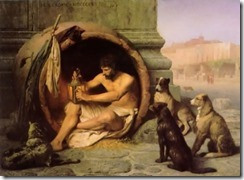 Here are some lines of ancient Greek verse about Diogenes the Cynic, and one about his student Monimos of Syracuse.
Here are some lines of ancient Greek verse about Diogenes the Cynic, and one about his student Monimos of Syracuse.
He is now no more, the Sinopean,
The staff-bearer with the doubled cloak who fed on the air,
But has gone off because he pressed his lips and teeth together
And held his breath; for he was Diogenes in very truth,
A son of Zeus and hound of heaven.
Cercidas of Megalopolis, in Diogenes Laertius. “Diogenes” means son of Zeus, and “Cynic” comes from the word for dog. These verses describe some of the stereotypical accoutrements and behaviours of the Cynics. Death by holding one’s breath was considered a form of suicide favoured by philosophers.
Even bronze yields to time, but your glory,
O Diogenes, will remain intact through all eternity,
Since you taught mortals the doctrine of self-sufficiency
And showed them the easiest path through life.
Engraved on bronze statues of Diogenes the Cynic erected in Corinth following his death, according to Diogenes Laertius. These lines might be taken to refer to what was considered the essence of the Cynic philosophy, the legacy of Diogenes being what the ancients describe as a “short-cut to virtue” consisting of a life of voluntary poverty and self-imposed hardship for the purposes of philosophical training.
The following relates to Monimos of Syracuse:
There was a man named Monimos, Philo, a wise one,
But none too famous – who carried a knapsack?-
Not one but three. Never did he use a saying
Like “Know thyself”, by heaven, or other of the quoted
Proverbs, no, he went much further, the dirty beggar,
And declared all human suppositions to be illusion.
From Menander’s comedy The Groom. Monimos, a student of Diogenes the Cynic, seems to be mocked here for being greedy compared to other Cynics, and carrying three knapsacks of food.
Filed under: Cynicism Tagged: Cynic philosophy, Cynicism, Diogenes the Cynic








March 9, 2013
Stoic Fatalism, Determinism, and Acceptance
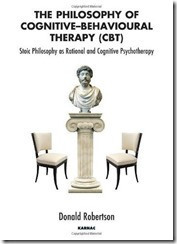 Excerpt from The Philosophy of Cognitive-Behavioural Therapy (CBT): Stoic Philosophy as Rational & Cognitive Psychotherapy (2010) by Donald J. Robertson.
Excerpt from The Philosophy of Cognitive-Behavioural Therapy (CBT): Stoic Philosophy as Rational & Cognitive Psychotherapy (2010) by Donald J. Robertson.
Whatever sorrow the fate of the Gods may here send us
Bear, whatever may strike you, with patience unmurmuring;
To relieve it, so far as you can, is permitted,
But reflect that not much misfortune has Fate given to the good. – The Golden Verses of Pythagoras
Paul Dubois was perhaps the first modern “rational” psychotherapist to explicitly argue that emotional problems could be made worse by certain, often unspoken, philosophical assumptions about freewill and determinism which prevail in modern society.
Patience towards unavoidable events, depending neither upon us nor upon others, is synonymous with fatalism; it is a virtue, and it is the only stand to take in face of the inevitable. […] The idea of necessity is enough for the philosopher. We are all in the same situation towards things as they are, and towards things that we cannot change. The advantage will always lie with him who, for some reason or other, knows how to resign himself tranquilly. (Dubois, 1909, pp. 240-241)
This notion is equally prominent in Stoic literature. In the Handbook, Epictetus boldly asserts that if we merely train ourselves in wishing things to happen as they do, instead of expecting them to happen as we wish, then our lives will go smoothly (Enchiridion, 8). In the Discourses, he actually defines the practice of philosophy in terms of such acceptance, when he writes, ‘Being educated [in Stoic philosophy] is precisely learning to will each thing just as it happens’ (Discourses, 1.12.15). In an extant fragment from his other teachings, he says that the man who refuses to accept his fortune is a “layman in the art of life” (Fragment 2).
The conceptual and metaphysical problem of freewill has been a central theoretical concern throughout the entire history of Western philosophy. However, Dubois, the Stoics, and others, have seen confusion over precisely this issue as a central psychotherapeutic concern. Dubois dedicates a whole chapter of his textbook on psychotherapy to the issue of determinism in which he asserts, ‘My convictions on this subject have been of such help to me in the practise of psychotherapy that I can not pass this question by in silence’ (Dubois, 1904, p. 47). However, in modern society we take certain metaphysical views regarding freewill for granted, and seldom examine whether they are well-founded, or even logically consistent.
There are some conclusions which we easily arrive at by using the most elementary logic, and which we dare not express. They seem to be in such flagrant contradiction to public opinion that we fear we should be stoned, morally speaking, and we prudently keep our light under a bushel. The problem of liberty is one of those noli me tangere [“do not touch me”] questions.
If you submit it to a single individual in a theoretical discussion, in the absence of all elementary passion, he will have no difficulty in following your syllogisms; he will himself furnish you with arguments in favour of determinism. But address yourself to the masses, or to the individual when he is under the sway of emotion caused by a revolting crime, and you will call forth clamours of indignation, – you will be put under the ban of public opinion. (Dubois, 1904, p. 47)
The philosophical debate concerning “freewill versus determinism” in modern academic philosophy is incredibly complex. Dubois only engages with it at a very superficial level. However, one aspect of the debate can perhaps be made explicit by means of a very crude syllogism of the kind Dubois had in mind.
Most people seem to assume that we generally act on the basis of freewill, which is constrained to varying degrees by obstacles in their environment. So a man is free from extrinsic restrictions or limitations, and therefore completely responsible for his actions, unless he is held at gunpoint, or brainwashed, etc. However, this popular way of looking at things seems to confuse two different concepts of “freedom”, that of freedom from the effects of preceding causal factors, and that of freedom to pursue future goals without obstruction. By contrast, the simple determinist position of Dubois can be outlined as follows,
All physical activity of the brain is wholly determined by antecedent causal factors.
All mental activity is wholly determined by physical activity in the brain.
Therefore, all mental activity is wholly determined by antecedent causal factors.
There are many variations of this argument, exhibiting different degrees of philosophical complexity and sophistication. However, this simple “premise-conclusion” format should at least be sufficient to expose the basic controversy. As Dubois observes, if we accept the physiological basis of the mind, ‘all thought being necessarily bound to the physical or the chemical phenomena of which the brain is the seat’, we are ultimately forced to abandon the metaphysical theory of freewill (Dubois & Gallatin, 1908, p. 9).
Doing so does not logically entail apathy and inertia, as many people falsely assume. Indeed, a man may be causally determined to respond to the perception of universal determinism with a sense of renewed commitment to his ideals, and to vigorous action.
At the exact moment that a man puts forth any volition whatever his action is an effect. It could not either not be or be otherwise. Given the sensory motor state, or the state of the intellect of the subject, it is the product of his real mentality. […] But it is nowhere written that the individual is going to persist henceforward in a downward course, that he is fatally committed to evil. But the fault having been committed, it should now be the time for some educative influence to be brought to bear, to bring together in his soul all the favourable motor tendencies and intellectual incentives, to arouse pity and goodness, or found on reason the sentiment of moral duty. (Dubois, 1904, pp. 55-56)
To a large extent, the defence of freewill has been a central concern of medieval Christian ethics and traditionally depends upon making a sharp metaphysical division between the body and the mind, such that our will can be considered the unfettered activity of a soul which exists independently of the body, a “ghost in the machine”, as Gilbert Ryle famously put it (Ryle, 1949).
However, if we accept the argument for determinism at face value it has radical implications for our attitudes toward ourselves and other people. It forces us to see other people as the product of genetics and environment and therefore acting in a manner which they cannot be “blamed” for in the ordinary sense of the word, i.e., in an absolute, metaphysical sense. We are all, to a large extent, victims of circumstance, insofar as we do what we do with the brains and the upbringing that nature has given us. Dubois puts this quite eloquently,
I know of no idea more fertile in happy suggestion than that which consists in taking people as they are, and admitting at the time when one observes them that they are never otherwise than what they can be.
This idea alone leads us logically to true indulgence, to that which forgives, and, while shutting our eyes to the past, looks forward to the future. When one has succeeded in fixing this enlightening idea in one’s mind, one is no more irritated by the whims of an hysterical patient than by the meanness of a selfish person.
Without doubt one does not attain such healthy stoicism with very great ease, for it is not, we must understand, merely the toleration of the presence of evil, but a stoicism in the presence of the culprit. We react, first of all, under the influence of our sensibility; it is that which determines the first movement, it is that which makes our blood boil and calls forth a noble rage.
But one ought to calm one’s emotion and stop to reflect. This does not mean that we are to sink back into indifference, but, with a better knowledge of the mental mechanism of the will, we can get back to a state of calmness. We see the threads which pull the human puppets, and we can consider the only possible plan of useful action – that of cutting off the possibility of any renewal of wrong deeds, and of sheltering those who might suffer from them, and making the future more certain by the uplifting of the wrong-doer. (Dubois, 1904, p. 56)
In other words, contemplation of determinism, the idea that human actions are definitely caused by a complex network of multiple preceding factors, mitigates our anger toward other people, and leads us closed to a healthy sense of understanding and forgiveness. We are also more enlightened regarding our practical responses and more inclined to reform rather than punish wrongdoers. When Socrates argued in The Republic that the Sage wishes to do good even to his enemies, he meant that the Sage sought to educate and enlighten others, seeing that as their highest good. That harmonious attitude is the polar opposite of the one which seeks revenge through moralising punishment. It leads to a sense of generosity and equanimity, and resolves anger, resentment, and contempt.
Like Dubois after them, the Stoics were determinists, who believed that all events in life, including our own actions, are predetermined to happen as they do. However, paradoxically, they were also passionately in favour of increased personal responsibility and belief in one’s freedom to act and make decisions in accord with reason. Hence, Epictetus constantly reminds his students that no matter what happens to them they still have the opportunity to make of life what they will.
Sickness is an impediment to the body, but not to the faculty of choice, unless that faculty itself wishes it to be one. Lameness is an impediment to one’s leg, but not to the faculty of choice. And say the same to yourself with regard to everything that befalls you; for you will find it to be an impediment to something else, but not to yourself. (Enchiridion, 9)
Epictetus himself was famously lame, reputedly after being brutally crippled by his master when enslaved, so these remarks must have carried an extra poignancy, given his obvious physical disability.
To many people this seems confusing and contradictory. How can the Stoics emphasise both freedom and determinism? However, as often proves the case in philosophy, it is not the answer which is confused but the question. The Stoics evidently believe that the concepts of freedom and determinism are compatible.
It is virtually certain that Epictetus’ concept of a free will, far from requiring the will’s freedom from fate (i.e., a completely open future or set of alternative possibilities or choices), presupposes people’s willingness to comply with their predestined allotment. The issue that concerns him is neither the will’s freedom from antecedent causation nor the attribution to persons of a completely open future and indeterminate power of choice. Rather, it is freedom from being constrained by (as distinct from going along with) external contingencies, and freedom from being constrained by the errors and passions consequential on believing that such contingencies must influence or inhibit one’s volition. (Long, 2002, p. 221)
Confusion is caused because of a well-known and long-standing ambiguity in the popular notion of “freewill”. Metaphysical “freedom” refers to the freedom of the soul to act independently of antecedent causal factors. However, by contrast, “freedom” in common parlance merely refers to the ability of something to perform its prescribed function without external impediment or obstruction. A wheel turns freely unless, for instance, it is buckled or stopped by a rock. People act freely unless, for instance, other people restrain them physically or mentally. ‘For he is free for whom all things happen in accordance with his choice, and whom no one can restrain’ (Discourses, 1.12.8).
The great Stoic academic, Chrysippus explained the Stoic theory of freewill and determinism by means of his famous “cylinder analogy”. In this example, it is argued that if we roll a cylinder along the ground, the initial impetus to move is given by someone pushing it, but the direction in which the cylinder moves, in a straight line, is determined by its own shape. The push is an example of what Stoics call an “external cause” coming from without, whereas the shape of the cylinder is the “internal cause” of the direction it takes, its own constitution. External causes impinge upon the human mind through the senses, and through other effects upon the body. However, the constitution, or character, of our mind determines how we will respond, acting as an “internal cause” of our response.
The mind is therefore autonomous to the extent that it can determine the direction in which it acts on the basis of its own character, however, external events impinge upon it and trigger its responses. Our actions are like the movement of the cylinder, insofar as both are due to a combination of “internal” and “external” factors. The cylinder is free to move according to its own nature so long as no further external causes obstruct it.
Whatever happens to you has been waiting to happen since the beginning of time. The twining strands of fate wove both of them together: your own existence and the things that happen to you. (Meditations, 10.5)
In this sense of the word “freedom”, which we should remind ourselves happens to be the normal sense, there is no incompatibility whatsoever with the notion of determinism because there is no reference made to the preceding causes which make the wheel turn, or the person act, in the first place. The cylinder rolls freely, its movement determined by antecedent events.
The notion of being free from preceding causes, by comparison, is a much more unusual and problematic concept. As Skinner argues at length in Beyond Freedom & Dignity, as our scientific understanding advances with regard to human behaviour, the notion that we were somehow exempt from universal determinism is very much eroded (1971, p. 21). He adds, ‘Although people object when a scientific analysis traces their behaviour to external conditions and thus deprives them of credit and the chance to be admired, they seldom object when the same analysis absolves them of blame’ (Skinner, 1971, p. 75).
But what of the inner feeling of freewill? Whatever sensations or impressions we might feel of “effort”, the idea that our actions are free is simply a sign that we are ignorant of their causes.
We do not think enough about the yoke inside, the result of ideas so thoroughly adopted that they seem like our own. That is what Spinoza meant when he said, “Men think themselves free only because they get a clear view of their actions, they do not think of the motives that determined them.” (Dubois, 1909, p. 53)
My freedom toward the future is a different matter and down to my specific circumstances in each situation, i.e., whether I am obstructed by external events or not.
When people are told that things happen because they have been determined by the preceding chain of causes they usually respond, at first, by complaining that there’s no point trying to change anything in that case. The Stoics and other ancient philosophers knew this as the “lazy argument”, and considered an obvious fallacy. The theory of determinism does not hold, as this fallacy requires, that all events are completely determined only by external causes, i.e., that people are completely passive in relation to the world. Rather, it holds that events are co-determined by the interaction of internal and external causes. My actions are part of the causal network, and therefore have an effect upon the things which happen. Nevertheless, accepting those things which are genuinely beyond my control, with philosophical resignation, is a key rational therapeutic strategy, and employed extensively by Stoics in the face of adversity.
Filed under: Excerpts, Philosophy of CBT, Stoicism Tagged: cbt, cognitive therapy, Stoic philosophy, stoicism








March 7, 2013
Menedemos: Cynic in Fancy Dress?
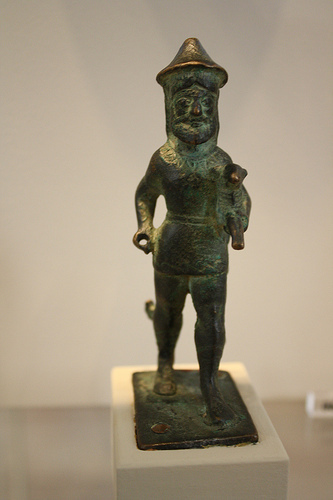
Man in Arcadian Pointy-Hat
Menedemos was a pupil of Colotes of Lampsacos [a pupil of Epicurus who also studied Cynicism in 3-4th century BC].
According to Hippobotos, he advanced to such a degree of imposture that he went around in the guise of a Fury [an ancient chthonic goddess of vengeance], saying that he had come from Hades to take note of sins that were committed, so as to be able to report them, on his return, to the deities below.
This was the manner of his dress: he wore a dark tunic reaching down to his feet, with a red belt tied around it, and an Arcadian hat on his head with the twelve signs of the zodiac embroidered on it, and tragic buskins, and he had an enormously long beard, and carried an ash-wood staff in his hand. (Diogenes Laertius)
Filed under: Stoicism Tagged: ancient, Cynic, Cynicism, Greek, philosopher, philosophy








Menedemos: Cynic Fancy Dress?

Man Wearing Arcadian Hat
Menedemos was a pupil of Colotes of Lampsacos [a pupil of Epicurus who also studied Cynicism in 3-4th century BC].
According to Hippobotos, he advanced to such a degree of imposture that he went around in the guise of a Fury [an ancient chthonic goddess of vengeance], saying that he had come from Hades to take note of sins that were committed, so as to be able to report them, on his return, to the deities below.
This was the manner of his dress: he wore a dark tunic reaching down to his feet, with a red belt tied around it, and an Arcadian hat on his head with the twelve signs of the zodiac embroidered on it, and tragic buskins, and he had an enormously long beard, and carried an ash-wood staff in his hand. (Diogenes Laertius)
Filed under: Stoicism Tagged: ancient, Cynic, Cynicism, Greek, philosopher, philosophy








March 5, 2013
Roundup of Recent Posts
March 4, 2013
The Succession of Philosophical Schools
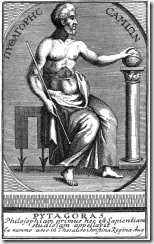 According to Diogenes Laertius’ The Lives of Eminent Philosophers, there were two major schools of ancient Greek philosophy, the Ionian and Italian schools, which divide into four distinct successions that survived down to the Hellenistic period. The Ionian School was founded by Thales and Anaximander, and their succession led down to Socrates, at which point his followers, “Socratics”, divided into two sub-divisions: The Cynic-Stoic tradition founded by Antisthenes and the Academic tradition founded by Plato. Plato’s student Aristotle then split off to form his own tradition, creating three sub-divisions of the Ionian succession. The Italian school began with Pherecydes and Pythagoras and ended with Epicurus.
According to Diogenes Laertius’ The Lives of Eminent Philosophers, there were two major schools of ancient Greek philosophy, the Ionian and Italian schools, which divide into four distinct successions that survived down to the Hellenistic period. The Ionian School was founded by Thales and Anaximander, and their succession led down to Socrates, at which point his followers, “Socratics”, divided into two sub-divisions: The Cynic-Stoic tradition founded by Antisthenes and the Academic tradition founded by Plato. Plato’s student Aristotle then split off to form his own tradition, creating three sub-divisions of the Ionian succession. The Italian school began with Pherecydes and Pythagoras and ended with Epicurus.
The Ionian School
Anaximander (Pupil of Thales)
Anaximenes
Anaxagoras
Archelaus
Socrates (“who introduced ethics or moral philosophy”)
The Italian School
Pythagoras (Pupil of Pherecydes)
Telauges (his son)
Xenophanes
Parmenides
Zeno of Elea
Leucippus
Democritus (who had many pupils)
Nausiphanes [and Naucydes] (in particular)
Epicurus
The Socratics
The Academic Succession
Plato (Student of Socrates, founder of the Old Academy)
Speusippus
Xenocrates
Polemo
Crantor
Crates
Arcesilaus (founder of the Middle Academy)
Lacydes (founder of the New Academy)
Carneades
Clitomachus (Succession ends)
The Cynic-Stoic Succession
Antisthenes (student of Socrates)
Diogenes the Cynic
Crates of Thebes
Zeno of Citium (founder of the Stoa)
Cleanthes
Chrysippus (Succession ends)
The Peripatetic Succession
Aristotle (student of Plato)
Theophrastus
Excerpt from Diogenes Laertius
But philosophy, the pursuit of wisdom, has had a twofold origin; it started with Anaximander on the one hand, with Pythagoras on the other. The former was a pupil of Thales, Pythagoras was taught by Pherecydes. The one school was called Ionian, because Thales, a Milesian and therefore an Ionian, instructed Anaximander; the other school was called Italian from Pythagoras, who worked for the most part in Italy. And the one school, that of Ionia, terminates with Clitomachus and Chrysippus and Theophrastus, that of Italy with Epicurus. The succession passes from Thales through Anaximander, Anaximenes, Anaxagoras, Archelaus, to Socrates, who introduced ethics or moral philosophy; from Socrates to his pupils the Socratics, and especially to Plato, the founder of the Old Academy; from Plato, through Speusippus and Xenocrates, the succession passes to Polemo, Crantor, and Crates, Arcesilaus, founder of the Middle Academy, Lacydes, founder of the New Academy, Carneades, and Clitomachus. This line brings us to Clitomachus.
There is another which ends with Chrysippus, that is to say by passing from Socrates to Antisthenes, then to Diogenes the Cynic, Crates of Thebes, Zeno of Citium, Cleanthes, Chrysippus. And yet again another ends with Theophrastus; thus from Plato it passes to Aristotle, and from Aristotle to Theophrastus. In this manner the school of Ionia comes to an end.
In the Italian school the order of succession is as follows: first Pherecydes, next Pythagoras, next his son Telauges, then Xenophanes, Parmenides, Zeno of Elea, Leucippus, Democritus, who had many pupils, in particular Nausiphanes [and Naucydes], who were teachers of Epicurus. (Diogenes Laertius)
Filed under: Stoicism Tagged: philosophy



















